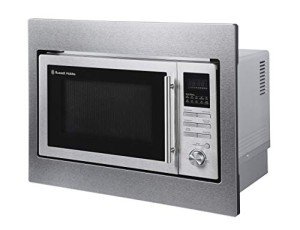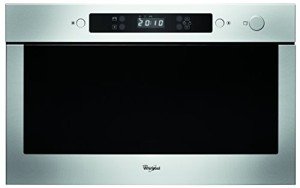15 Best Microwave Built Bloggers You Should Follow
페이지 정보
작성자 Lakesha 작성일24-11-24 23:58 조회2회 댓글0건관련링크
본문
 How is a Microwave 45cm built in microwave?
How is a Microwave 45cm built in microwave?Microwave ovens have brought home convenience to a new level. They can be placed in cabinets for wall use or on top of kitchen islands. They are also constructed from a variety of materials.
The cavity magnetron tube that emits microwaves was first invented in 1940 at Birmingham University in England. Percy Spencer realized that this device could be used to heat food when he watched corn pop and eggs cook.
Raw Materials
Microwave (MW) heating is gaining a lot of attention in material processing due to its inherent advantages like rapid heating, uniform heating, non-contact nature, and low energy consumption. Heating with MW can be applied on a wide range of engineering materials, including ceramics, metals, and polymers. Recently, it was used to bulk metal joins, making dissimilar metallic powders clad on metallic substrates, and casting.
Metal is the most important material used in microwave ovens. It is extracted from the earth through processes that consume lots of energy and emit greenhouse gases. Plastic is another important material that is made from organic substances such as cellulose and crude oils. Plastic production produces indirect greenhouse gases due to the use of fossil fuels to generate electricity and heat, and direct emissions from chemical processing like the production of phthalates and Bisphenol A.
Once the raw materials have been acquired, they are then subjected to extensive manufacturing and quality controls to ensure that they are in compliance with strict federal standards. In this process, a range of emissions and wastes are produced, such as oils, solvents dust, fumes, and dust. The finished product is delivered to retailers, and finally to consumers. Most microwaves are shipped by truck. This also uses a lot of energy, and generates greenhouse gasses.
After purchasing a microwave it will typically be used for a few years before it is no longer needed and removed. Since the life span of microwaves is short recycling and end-of-life disposal options are essential in reducing emissions and waste.
Design
Microwave ovens cook food by emitting electromagnetic waves within the microwave region (300 MHz to 300 GHz). The microwave oven cooks food by passing the radiation through it. The microwave ovens are designed to shield the user from harmful effects of the radiation. This is due to arcing, which can cause damage to the oven or the food inside. There are many different types of microwavable ovens that are available. Each one has its own pros and cons. Consider the dimensions of your kitchen, the size of it and your cooking needs when choosing a microwave. If you are limited in counter space, consider a built in model that hides the appliance.
The innovative design of a microwave oven begins with the purchase of raw materials. These are then processed into various components. This includes the oven cavity and frame, turntable, glass tray, magnetron tube (with capacitor and transformer), diode, waveguide, and electromechanical components (motors relays, switches, and motors). The casing is constructed of metal, such as galvanized steel, aluminum, or brass.
The microwave is packaged and tested following the assembly. The packaging is usually composed of recycled materials like cardboard and paper, or recyclable plastics, such as acrylonitrile butadiene styrene polyethylene terephthalate or polyvinyl chloride.
The new microwaves are then transferred to transport tools like planes, ships, or cars. These tools use fossil fuels to convert chemical energy into mechanical energy, which is used to move microwaves from their location to the users. After the microwaves are delivered, they can be plugged in by the user to be used. This is the phase of the life cycle that uses the most energy and creates the most emissions, including carbon dioxide.
Manufacture
Microwaves are an essential appliance in modern kitchens. They are known for their speed and convenience however, what exactly is it that makes a microwave work? To find out, let's take an overview of the process of making this household staple.
The basic materials required to build microwave ovens include metals, plastic components and other electrical components. These can be obtained from the earth, however some require processing to produce them. The process of manufacturing also requires the use of energy, which results in the emission of greenhouse gases. This stage of production is the main cause of a microwave's environmental impact.
During the manufacturing stage the majority of the material is assembled using automated machines. The assembly process is carried out in factories where workers are working on a conveyor. Workers utilize a machine for creating sheet metal into the door's outer casing and. After the frame is constructed and cleaned, it is then rinsed with an alkaline cleaner in order to remove oil and dirt. The frame is then put together with screws and bolts to create an uninjured chassis.
Magnetrons and other components can be installed after the chassis has been constructed. The magnetron emits microwaves that cause water molecules to warm up. During this phase there are safety hazards like the possibility that plasticizers be released into food items or the oven may explode if it's empty.
The microwave is thoroughly tested and inspected once it is assembled to make sure it is in compliance with the standards of the federal government. The microwave is then packaged and distributed to the public. The transportation of microwaves between the factory and retailers can be a significant environmental burden. The equipment used to transport and transmit microwaves are powered by fossil fuels, which release greenhouse gases and carbon dioxide into the air.
Testing
Microwaves are a type of electromagnetic radiation that forms part of the electromagnetic spectrum of waves. The spectrum consists of a variety of forms of energy that move through space, such as radio waves, visible light, infrared energy, and ultraviolet radiation. Microwaves heat food using the process known as microwave heating. This uses electromagnetic radiation to cause water molecules to vibrate and spin. This causes food to be heated without heating the air around it or altering the physical structure of the food.
Microwaving is a secure method of heating food since the microwave radiation doesn't affect the food cells or cause them to become radioactive. However, those with pacemakers should stay clear of microwaves as the radiation could interfere with the electrical signals from certain electronic cardiac devices. Fortunately, this issue has been addressed by the use of shielding devices that are specially designed for.
Some of the chemicals used in microwave ovens pose a risk to your health, including bisphenol A (BPA) and phthalates. BPA has been proven to leach into food from plastic containers, and phthalates can be associated with increased risk of reproductive problems. Additionally microwave radiation can cause damage to the eye tissues and lead to cataracts.
The test procedures of the current NOPR require that microwave with grill built in ovens be tested in their microwave-only cooking mode as well as convection-microwave cooking modes in order to determine the energy consumption of appliances under typical usage conditions. The test method employs a mixture of water and other basic ingredients to simulate food that can be reheated using the microwave. The mixtures are then poured into a borosilicate glass container, heated up in the microwave, and measured for thermal efficiency.
Packaging
Many microwave-ready meals use special packaging techniques known as modified atmosphere packing (MAP). This method of packaging utilizes oxygen-eliminating gases to extend the shelf-life of pre-cooked foods. These gases are usually made up of carbon dioxide or pure nitrogen and oxygen. They work by removing air that is a part of the food's environment. This prevents spoilage and extends the time of the meal for the consumer.
The MAP process can also be used for meat products, including frozen steaks, chicken wings, or beef patties. These packages contain a nonwoven material that absorbs moisture and helps keep the food moist and fresh for a longer period of time. This type of packaging minimizes waste since it reduces the quantity of air and water that are lost in the heating process.
 When choosing a microwave, consumers should consider its size as well as its power level and other features, such as sensor cooking or defrost options. These features can make cooking easier but you must also be aware of how often you use them. In other words, it's not worth purchasing a microwave that has additional features. Another thing to consider is the design of the microwave. Some models have a flush-best built in combi microwave-in design which fits seamlessly into existing cabinets.
When choosing a microwave, consumers should consider its size as well as its power level and other features, such as sensor cooking or defrost options. These features can make cooking easier but you must also be aware of how often you use them. In other words, it's not worth purchasing a microwave that has additional features. Another thing to consider is the design of the microwave. Some models have a flush-best built in combi microwave-in design which fits seamlessly into existing cabinets.댓글목록
등록된 댓글이 없습니다.




